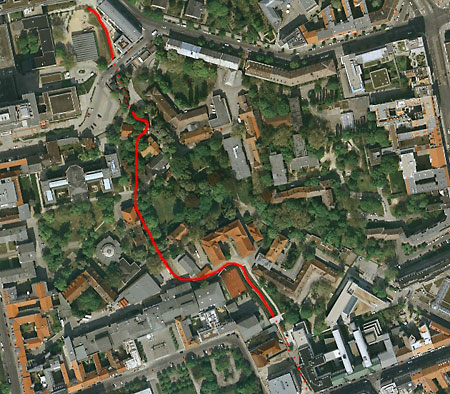A Word on Rivers on Sunday
This posting was supposed to be a different one. Cause for the schism: a digital camera which happily took twenty photos during the day, but which later innocently claimed to have no memory of them. “No Image” it says, white text on a black background. Either time for a new camera, or cause for a minute or two of reflection on the ephemerality of all things.
I wanted to write about the river Panke, a tiny tributary of the larger Spree in Berlin. I took lots of lovely photos of it, even standing in it at one point to capture the way the sunlight was beautifully falling through the trees onto it. (The river-bed was dry at this point, so sacrifices to personal health were minimal.) Readers are asked kindly to imagine this scene whilst consulting the following which image I culled from Google Earth and hastily embelished in Photoshop.

The red line is the visible part of the river, the dotted part marks its subterranean route.
I was reminded of Stephen Smith’s Underground London: Travels Beneath the City Streets which I gave to my father as a Christmas present last year. It partly described the astonishing history of London’s old lost rivers, such as the Fleet, which during medieval times was so full of filth and oomska that one could cross it by foot. It was later buried beneath a famous street of the same name, and assimilated into part of the city’s sewer system.
In 1961 the course of the Panke was halted during construction of the Berlin wall, and has run more or less dry since then. From medieval times until well into the 19th Century, the Panke was integrated into city life with many water mills drawing their power from its flow. It was even prone to flooding, destroying an entire paper mill in 1839. Hard to imagine these days. Oddly, too, the point at which the Panke meets the Spree has its own address. Number 2, Schiffbauerdamm, just in front of the Berliner Ensemble Theater, as attests an old Berliner saying:
“Am Schiffbauadamm Numma zwee,
da fließt de Panke in de Spree.”
All is not lost. The private company Grün Berlin Park und Garten GmbH have been responsible for much of the Panke’s recent upkeep, in particular around the area shown above in the grounds of the Charité hospital and Humboldt University’s Faculty of Vetinary Medicine. Plans to extend restauration along a 20km stretch of the river are apparently filed under ‘high-priority’ at the Berlin Senate.